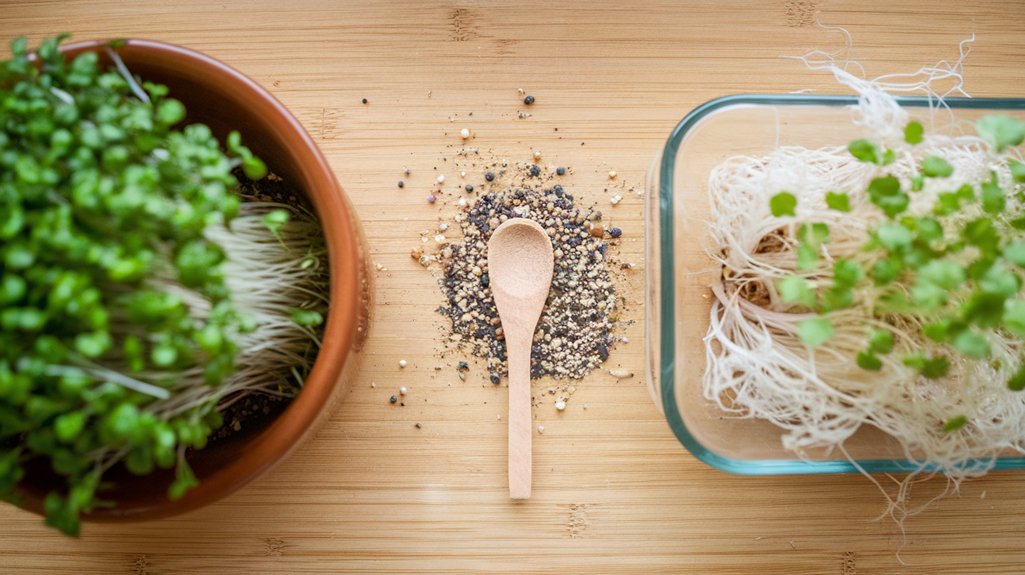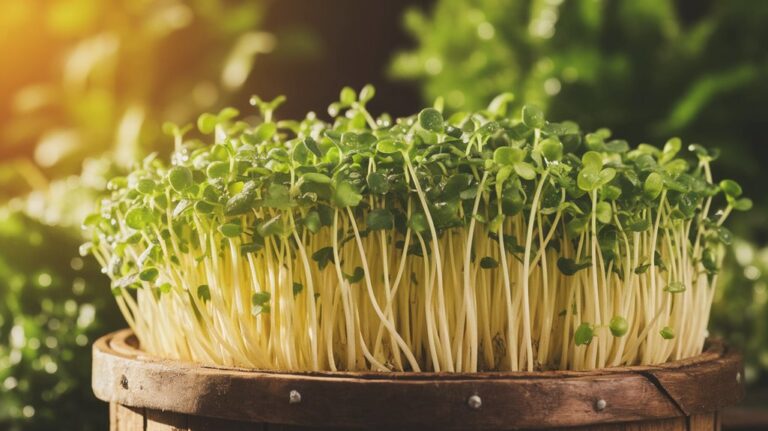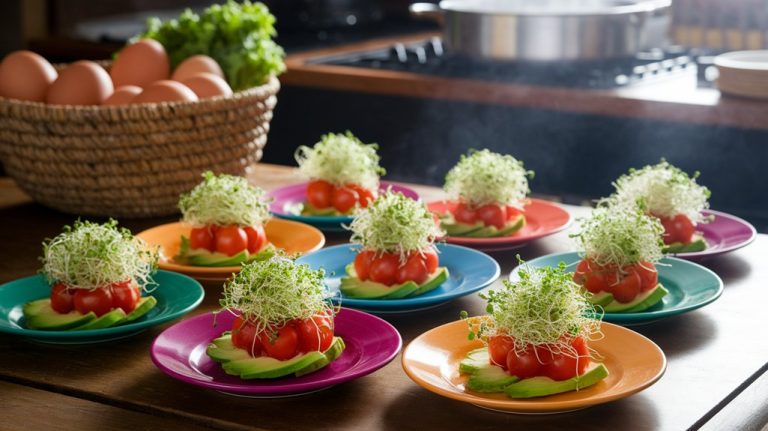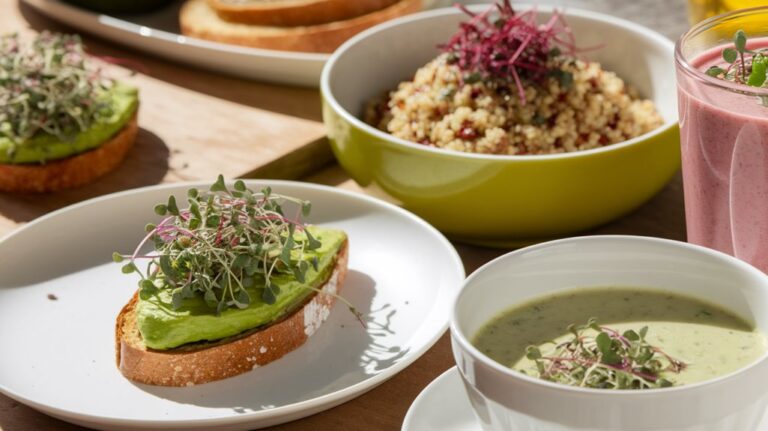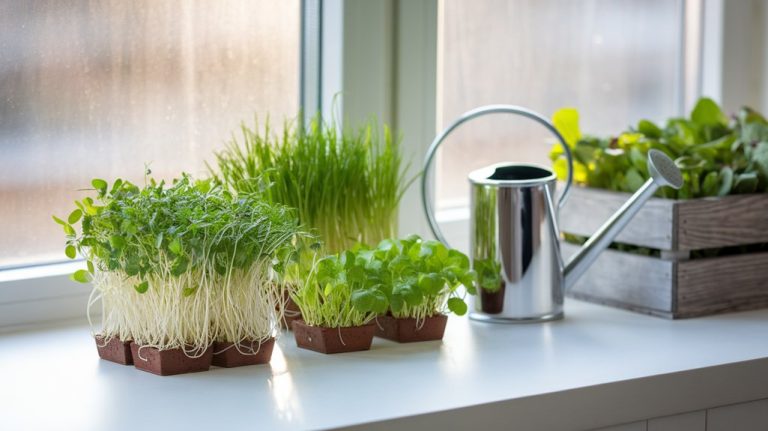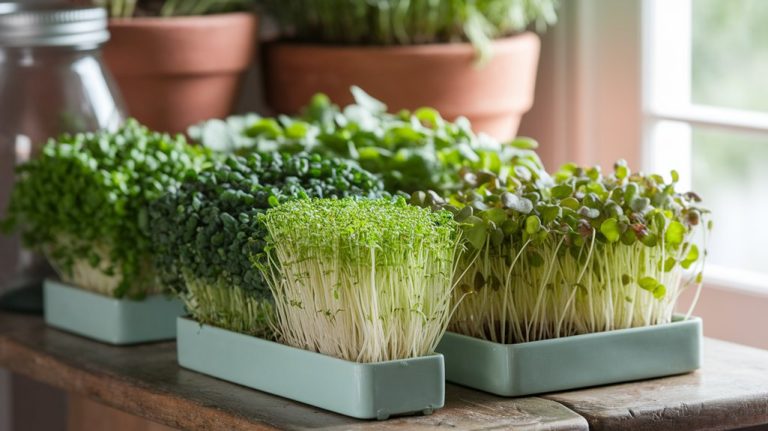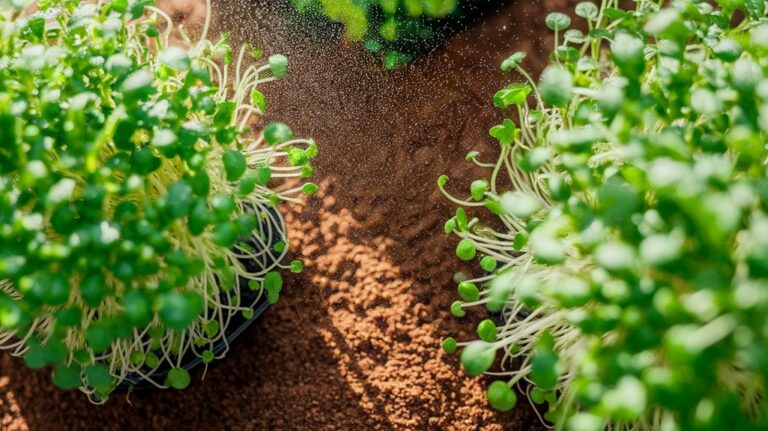Microgreens vs. Sprouts: Which Is Better for Your Diet?
When it comes to microgreens and sprouts, I find microgreens to be the better choice for my diet. They pack up to 40 times more nutrients, including vitamins C, E, and K, and offer a rich source of antioxidants. While both add flavor and nutrition to meals, microgreens have a superior nutrient density. Sprouts also provide benefits, but for a robust nutrient boost, microgreens win out. If you’re curious about how to grow them at home and their culinary uses, there’s more to explore!
Key Takeaways
- Microgreens are generally more nutrient-dense, offering higher levels of vitamins and minerals compared to sprouts per gram.
- Microgreens provide enhanced health benefits, including more antioxidants, which help reduce oxidative stress and lower chronic disease risk.
- Sprouts are low in calories and rich in fiber, making them great for weight management and digestive support.
- Both microgreens and sprouts add unique flavors and textures to dishes, enhancing culinary versatility in salads, sandwiches, and other meals.
- Choosing between them depends on your nutritional needs and culinary preferences, as both offer distinct health benefits.
What Are Microgreens?
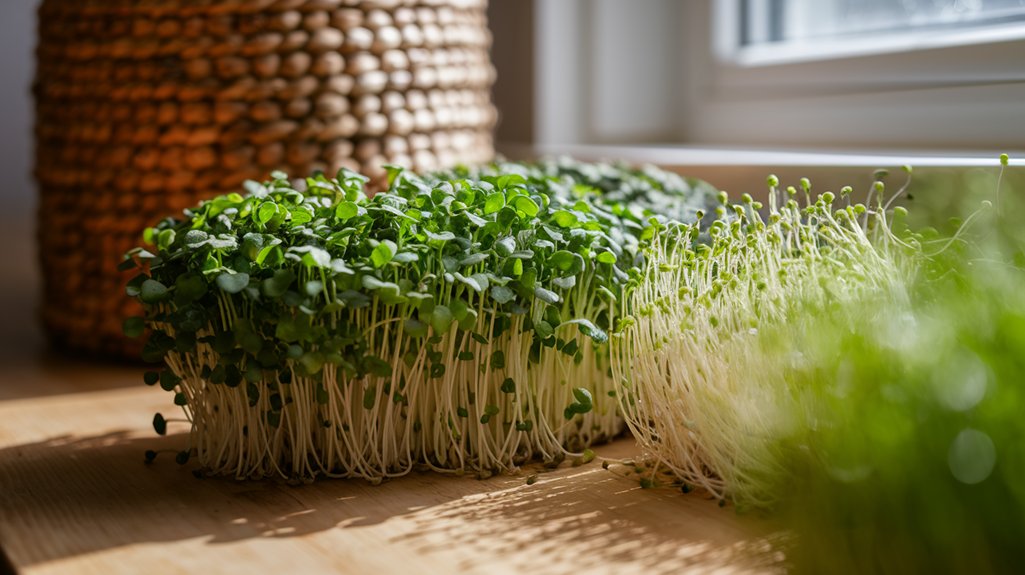
Microgreens are tiny, nutrient-dense plants that pack a flavorful punch. I love incorporating them into my meals for their vibrant taste and impressive health benefits.
Typically harvested when they’re just a few inches tall, microgreens come from various vegetables, herbs, and even some grains. Studies show they can contain up to 40 times the nutrients of their mature counterparts, including vitamins C, E, and K, as well as antioxidants.
I often choose varieties like arugula, kale, and basil not just for their taste but also for their potential health advantages. They’re easy to grow at home, making them a convenient option for anyone looking to enhance their diet.
What Are Sprouts?
Sprouts are young plants that are harvested just days after germination, offering a fresh and crunchy addition to a variety of dishes. They’re typically grown in water without soil, which allows them to develop quickly. Popular types of sprouts include alfalfa, broccoli, and radish. I love using them in salads, sandwiches, and wraps for that extra crunch and flavor.
One of the fascinating aspects of sprouts is their versatility. They can be grown indoors or outdoors, making them accessible for home cultivation.
However, it’s important to note that sprouts can be prone to bacterial contamination if not handled properly. So, always choose organic and reputable sources, and rinse them thoroughly before consuming. This ensures you’re enjoying sprouts safely and deliciously.
Nutritional Comparison: Microgreens vs. Sprouts
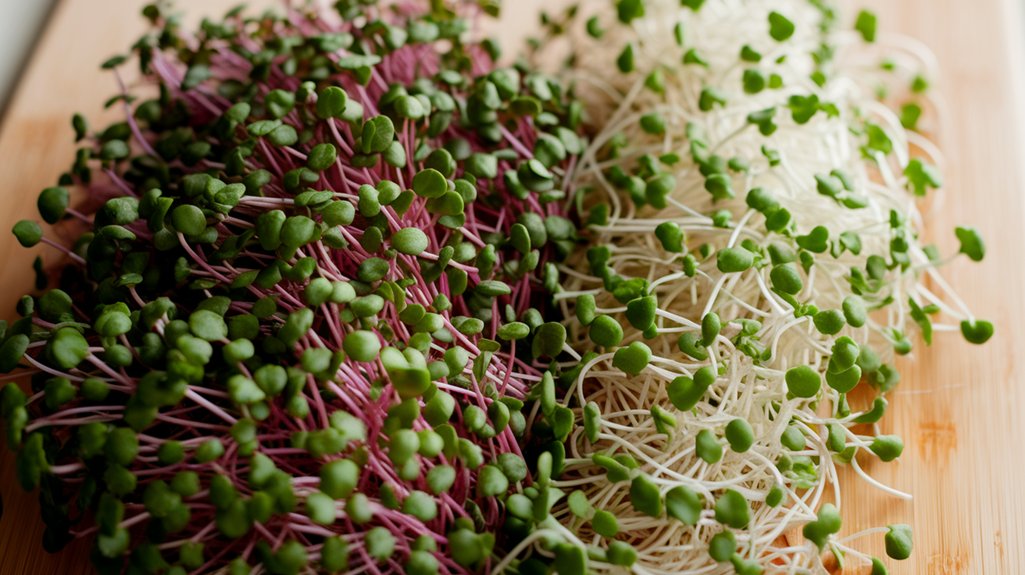
When comparing microgreens and sprouts, I find the differences in nutrient density quite interesting.
Research shows that microgreens often pack more vitamins, minerals, and antioxidants than their sprouted counterparts.
Let’s explore how these variations can impact your diet and overall health.
Nutrient Density Differences
While both microgreens and sprouts are celebrated for their health benefits, their nutrient density varies significantly.
I’ve found that microgreens typically pack a more concentrated nutritional punch. They’re often harvested at a later stage than sprouts, allowing them to develop more complex flavors and nutrients. Research indicates that microgreens can contain up to 40 times higher levels of vitamins and minerals compared to their mature counterparts.
Sprouts, on the other hand, are germinated seeds that focus on protein and fiber, but they generally have lower nutrient density overall.
Vitamin and Mineral Content
Microgreens often shine in terms of vitamin and mineral content, making them a standout choice for anyone looking to enhance their diet. Research shows that microgreens can pack significantly higher levels of essential nutrients compared to sprouts. For instance, the concentration of vitamins and minerals can be dramatically higher per gram. Here’s a quick comparison:
| Nutrient | Microgreens (per 100g) | Sprouts (per 100g) |
|---|---|---|
| Vitamin C | 150 mg | 30 mg |
| Vitamin K | 200 mcg | 40 mcg |
| Calcium | 150 mg | 15 mg |
Choosing microgreens can help you boost your intake of vital nutrients effectively, making them a worthy addition to your meals.
Antioxidant Levels Comparison
Although both microgreens and sprouts offer health benefits, their antioxidant levels can differ significantly, making it important to understand what each brings to the table.
Microgreens are known to pack a powerful antioxidant punch. Research shows they can contain up to 40 times more antioxidants than their mature counterparts. For instance, varieties like red cabbage and sunflower microgreens stand out in terms of antioxidant content.
On the other hand, sprouts, such as alfalfa and mung bean, do contain beneficial compounds but typically have lower levels of antioxidants compared to microgreens. This distinction makes microgreens a more robust choice if you’re specifically seeking antioxidant benefits.
Ultimately, I think incorporating both into your diet can offer a well-rounded nutritional boost.
Health Benefits of Microgreens
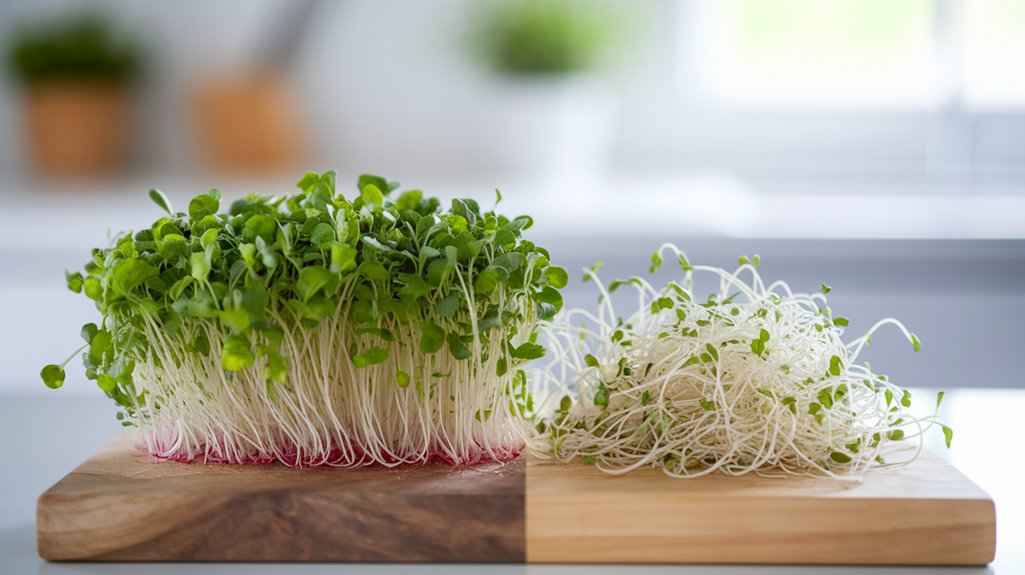
When I think about the health benefits of microgreens, their impressive nutrient density really stands out to me.
Research shows they can pack a powerful punch of vitamins and antioxidants, which can enhance our overall well-being.
Plus, their culinary versatility makes it easy to incorporate them into various dishes, adding both flavor and nutrition.
Nutrient Density Comparison
While both microgreens and sprouts offer impressive health benefits, the nutrient density of microgreens often takes the spotlight.
Research shows that microgreens can contain up to 40 times more vitamins and minerals than their mature counterparts. For example, I’ve found that varieties like broccoli and kale microgreens are particularly rich in vitamins C, E, and K, essential for overall health. Additionally, they’re packed with minerals such as calcium and magnesium.
On the other hand, sprouts tend to have lower nutrient levels due to their shorter growth period. While both options can enhance your diet, if you’re looking for a concentrated source of nutrients, I’d recommend incorporating microgreens into your meals whenever possible. They’re a vibrant way to boost your nutritional intake.
Antioxidant Properties Explained
As I delve into the health benefits of microgreens, one standout feature that catches my attention is their impressive antioxidant properties. Research shows that microgreens can contain up to 40 times more antioxidants than their mature counterparts.
These compounds, such as vitamins C and E, fight free radicals in our bodies, reducing oxidative stress and lowering the risk of chronic diseases. I find it fascinating that different varieties of microgreens offer varying levels of these beneficial compounds; for instance, red cabbage and broccoli microgreens are particularly high in antioxidants.
Incorporating a mix of these tiny greens into my diet not only enhances flavor but also boosts my overall health. It’s a simple yet effective way to support my well-being.
Culinary Versatility Advantages
Microgreens offer incredible culinary versatility that can elevate any dish. I love adding them to salads, sandwiches, and even smoothies for an instant flavor boost. Their vibrant colors and unique tastes, ranging from spicy to nutty, make them perfect for garnishing and enhancing presentation.
Research shows that these tiny greens are packed with nutrients, which means I’m not just adding flavor but also health benefits to my meals. Additionally, their quick growth cycle makes them accessible for home gardeners, allowing me to enjoy fresh greens year-round.
Whether I’m whipping up a simple breakfast or an elaborate dinner, incorporating microgreens adds depth and complexity, making my dishes not just healthier, but also more visually appealing and satisfying.
Health Benefits of Sprouts
Many mightn’t realize just how nutritious sprouts can be. These tiny powerhouses pack a punch when it comes to vitamins, minerals, and antioxidants.
Research shows that sprouts are rich in essential nutrients like vitamins A, C, and K, along with folate and fiber. They can support digestion and help boost your immune system. Moreover, sprouts are low in calories, making them a great addition to weight management plans.
I’ve found that incorporating them into my meals not only enhances flavor but also increases nutritional value. However, it’s crucial to source sprouts from reliable suppliers to minimize the risk of foodborne illnesses.
How to Grow Microgreens at Home
Growing microgreens at home is a rewarding and straightforward process that can elevate your culinary creations.
To start, I recommend choosing seeds like arugula, radish, or basil. You’ll need a shallow tray filled with potting soil; spread the seeds evenly and cover them lightly with soil.
Water them gently, ensuring the soil stays moist but not soggy. Place the tray in a sunny spot or under grow lights for about 4-14 days, depending on the variety.
Once they’re about 2-3 inches tall, it’s time to harvest! Simply snip them just above the soil line.
Microgreens not only add flavor and color to dishes, but they’re also packed with nutrients, making them a fantastic addition to your meals.
How to Grow Sprouts at Home
While the process might seem similar to growing microgreens, cultivating sprouts at home is unique and can be just as rewarding.
To start, I soak seeds like alfalfa or mung beans in water for about 8 hours. After draining, I place them in a jar with a breathable lid or a sprouting tray. I rinse them with water twice daily, ensuring they stay moist but not waterlogged.
In about 3 to 7 days, I’ll notice tiny green shoots emerging. Sprouts thrive in indirect sunlight, so I keep them in a well-lit area but not directly under the sun.
Once they’re ready, I give them a final rinse, and then they’re perfect for adding to salads or sandwiches!
Culinary Uses of Microgreens
Although I often enjoy experimenting with various ingredients in my cooking, microgreens have quickly become a staple in my culinary repertoire. Their vibrant colors and intense flavors elevate any dish, whether I’m adding them to salads, sandwiches, or garnishing soups.
Rich in nutrients, microgreens provide a concentrated source of vitamins and minerals, which makes them not only tasty but also beneficial for my health. I love incorporating varieties like arugula or basil for a peppery kick or sweetness, respectively.
Additionally, they’re incredibly versatile; I can blend them into smoothies or use them as a topping for omelets. Overall, microgreens not only enhance the visual appeal of my meals but also offer a burst of flavor and nutrition that’s hard to resist.
Culinary Uses of Sprouts
Sprouts have become an exciting addition to my kitchen, as they offer a unique crunch and flavor that can enhance a variety of dishes. I often toss alfalfa sprouts into salads for added texture, or sprinkle radish sprouts atop sandwiches for a peppery kick.
Their versatility means I can incorporate them in wraps, grain bowls, or even omelets. Nutritionally, sprouts pack a punch, being rich in vitamins, minerals, and antioxidants.
I also appreciate how easy they’re to grow at home, ensuring freshness and quality. Just remember to rinse them well to reduce any risk of contamination.
Frequently Asked Questions
Can Microgreens and Sprouts Be Grown Together?
I’ve found that microgreens and sprouts can indeed be grown together, and it’s a fun project!
They both require similar conditions, like light and moisture, but their growth rates can differ. I typically start the sprouts a few days earlier to ensure they’re ready at the same time.
This way, I get the best of both worlds—a vibrant mix of flavors and nutrients in my dishes. Give it a try; you won’t regret it!
How Long Do Microgreens and Sprouts Last in the Fridge?
When I store microgreens in the fridge, they usually last about 5 to 14 days, depending on the variety and freshness when purchased.
Sprouts, on the other hand, typically last around 3 to 7 days.
I always make sure to keep them in a breathable container to prevent moisture buildup.
If I notice any signs of wilting or spoilage, I toss them out to ensure I’m eating the freshest options possible.
Are Microgreens or Sprouts More Environmentally Friendly?
When I think about environmental impact, both microgreens and sprouts have their perks.
Microgreens usually require more water and space, but they’re often grown in controlled environments that can reduce pests and diseases.
Sprouts, on the other hand, need minimal resources and can be grown indoors without soil.
Can Children Eat Microgreens and Sprouts Safely?
Absolutely, children can safely eat microgreens and sprouts, but it’s crucial to ensure they’re grown and handled properly.
I’ve found that microgreens are typically safer due to their shorter growth cycle and lower risk of pathogens.
Sprouts, on the other hand, can harbor bacteria if not rinsed and stored correctly.
I always recommend introducing these foods gradually and consulting a pediatrician if you have concerns about allergies or dietary restrictions.
What Are the Best Seeds for Growing Microgreens or Sprouts?
When choosing seeds for growing microgreens or sprouts, I’ve found that options like broccoli, radish, and kale are fantastic for microgreens due to their rich flavors and nutrient density.
For sprouts, I prefer alfalfa, mung beans, and lentils, as they’re easy to grow and packed with vitamins.
Always ensure you’re using seeds specifically labeled for sprouting or microgreens to avoid any harmful chemicals.
It’s all about picking the right seeds for the best results!
Conclusion
In conclusion, both microgreens and sprouts offer unique nutritional benefits and can enhance your diet in different ways. While microgreens tend to be richer in vitamins and minerals, sprouts are often easier to digest and packed with enzymes. Ultimately, the choice between them depends on your personal taste and dietary needs. By incorporating both into your meals, you can enjoy a diverse range of flavors, textures, and health benefits. It’s all about what works best for you!

